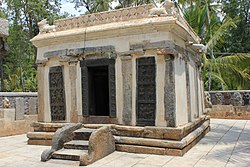Arakeshvara Temple, Hole Alur
Arakeshvara Temple | |
|---|---|
Hindu temple | |
 View of Arakeshvara temple mantapa (10th century A.D.) | |
| Country |  India India |
| State | Karnataka |
| District | Chamarajanagar District |
| Languages | |
| • Official | Kannada |
| Time zone | UTC+5:30 (IST) |


The Arakeshvara Temple, dedicated to the Hindu god Shiva, is located in the village of Hole Alur in the Chamarajanagar district of Karnataka state, India. According to the historian Sarma, the temple which dates back to the middle of the 10th century rule of the Western Ganga Dynasty appears to have been renovated in later periods. It was constructed by King Butuga II around 949 A.D. to celebrate his victory over the Cholas of Tanjore in the historically important battle of Takkolam. It was a military engagement between crown prince Rajaditya, son of the Chola King Parantaka I, and King Butaga II (a powerful vassal of the Rashtrakuta emperor Krishna III).[1][2][3][4][5] The temple is protected as a monument of national importance by the central Archaeological Survey of India.[3][6]
Temple plan
The temple has a simple plan characteristic of Western Ganga constructions. It has a sanctum (garbhagriha), a vestibule (called sukhanasi) that connects to the sanctum a large well sculptured closed hall (navaranga or mahamantapa) and an open, elevated and detached mantapa outside facing the shrine containing the sculptured image of nandi (the companion of the Hindu god Shiva) facing east (called the nandimantapa). The base on which the temple is raised (called adhishthana) is a simple set of moldings.[3]
The overall decoration is simple with dancing celestial maiden (apsaras) within volutes of scrolls (lata-patra, lit, "creeper leaf") which extend over the door jamb and linel. On either side of the entrance doorway are two tall rectangular vertical slabs reaching up to the lintel, divided into four panels with relief friezes depicting male drummers (called dola-nritya). The top panel has rustic male dancers who appear to dance to a musicians' ensemble who play the drum, violin, rudra veena, flute and the kanjira. According to the historian Sarma, in no contemporary temple are such native (desi) forms of dance depicted.[7] The most interesting bas-relief sculptures in the temple, according to Sarma, are the ones on the rounded pillars in the nandimantapa and the closed mahamantapa. These relief vividly depict the victory of Butaga II over the Chola prince Rajaditya, in addition to themes from the Hindu epics, mythical figures and demi-gods.[3][5][8] The high point of the relief work, in the closed mahamantapa is the ashtadikpalaka grid ("guardians of eight directions") in the ceiling with a central dancing Shiva (called natya shiva). There are several independent sculptures in the closed hall, including Mahishasuramardini (version of the goddess Durga slaying an asura), Yago Dakshinamurthy (god Shiva as "the teacher"), Saptamatrika (seven celestial mothers) and other sculptures that adhere to the 8th-9th century Ganga-Chalukya sculptural idiom.[9]
Notes
- ^ Kamath (1980), p.83
- ^ Sastri (1955), p.162
- ^ a b c d "Sri Arakesvara temple". Archaeological Survey of India, Bengaluru Circle. Archaeological Survey of India. Retrieved 15 November 2014.
- ^ Chopra, Ravindran and Subrahmanian (2003), p.97
- ^ a b Sarma (1992), p.21, p.111
- ^ "Alphabetical List of Monuments – Karnataka -Bangalore, Bangalore Circle, Karnataka". Archaeological Survey of India, Government of India. Indira Gandhi National Center for the Arts. Retrieved 15 July 2012.
- ^ Sarma (1992) p.107
- ^ Sarma (1992), pp.109-110
- ^ Sarma (1992), p.107
References
- "Sri Arakesvara temple". Archaeological Survey of India, Bengaluru Circle. Archaeological Survey of India. Retrieved 7 July 2012.
- Kamath, Suryanath U. (2001) [1980]. A concise history of Karnataka : from pre-historic times to the present. Bangalore: Jupiter books. LCCN 80905179. OCLC 7796041.
- Sarma, I.K. (1992) [1992]. Temples of the Gangas of Karnataka. New Delhi: Archaeological Survey of India. ISBN 0-19-560686-8.
- Sastri, Nilakanta K.A. (2002) [1955]. A history of South India from prehistoric times to the fall of Vijayanagar. New Delhi: Indian Branch, Oxford University Press. ISBN 0-19-560686-8.
- Chopra, P.N.; Ravindran, T.K.; Subrahmanian, N (2003) [2003]. History of South India (Ancient, Medieval and Modern) Part 1, The Cholas-Vijayalaya line. New Delhi: Chand Publications. ISBN 81-219-0153-7.
Gallery
- "Guardians of eight directions" in relief on mahamantapa ceiling in Arakeshvara temple at Hole Alur
- Natya Shiva (dancing Shiva) depiction on ceiling in Arakeshvara temple at Hole Alur
- A "guardian" (dikpala) on the ceiling in Arakeshvara temple at Hole Alur
- A "guardian" on the ceiling in Arakeshvara temple at Hole Alur
- mantapa pillar with intricate bas-relief in the Arakeshwara temple at Hole Alur
- Nandi mantapa pillar with depictions from the battle of Takkolam in relief in the Arakeshwara temple at Hole Alur
- Musicians in relief on vertical slab in the Arakeshwara temple at Hole Alur
- Hero stone with relief sculpture in the Arakeshwara temple at Hole Alur
- Dakshinamurthy in the Arakeshwara temple at Hole Alur
- Mahishasuramardini in the Arakeshwara temple at Hole Alur
- Deity sculpture in relief in the Arakeshwara temple at Hole Alur
- Varaha in relief in the Arakeshwara temple at Hole Alur
External links

























